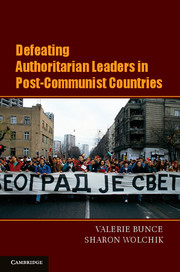Book contents
- Frontmatter
- Contents
- List of Figures and Tables
- Acknowledgments
- PART I THE PUZZLE
- PART II CASE STUDIES
- 3 The 1998 Elections in Slovakia and the 2000 Elections in Croatia
- 4 Defeating a Dictator at the Polls and in the Streets
- 5 Ukraine
- 6 Georgia and Kyrgyzstan
- 7 Failed Cases
- PART III COMPARATIVE ANALYSES
- Appendix
- Index
4 - Defeating a Dictator at the Polls and in the Streets
The 2000 Yugoslav Elections
Published online by Cambridge University Press: 05 June 2012
- Frontmatter
- Contents
- List of Figures and Tables
- Acknowledgments
- PART I THE PUZZLE
- PART II CASE STUDIES
- 3 The 1998 Elections in Slovakia and the 2000 Elections in Croatia
- 4 Defeating a Dictator at the Polls and in the Streets
- 5 Ukraine
- 6 Georgia and Kyrgyzstan
- 7 Failed Cases
- PART III COMPARATIVE ANALYSES
- Appendix
- Index
Summary
Mečiar was Mother Theresa in comparison with Milošević.
Otpor activistMilošević made citizens of Serbia stoop so low that we had to use protest and even violence to make him leave office after he was defeated in the election.
Boris BegovićIn the last chapter, we analyzed the 1998 election in Slovakia and the 2000 election in Croatia. These elections were of interest in part because they were so similar. For example, while the incumbents had used authoritarian methods to rule, and these methods had included tinkering with electoral districts and rules in ways that served their reelection interests, the 1998 election in Slovakia and the election that took place two years later in Croatia were largely free and fair. Moreover, international democracy promoters made significant contributions to both of these elections, and in both cases the opposition succeeded, in direct contrast to its past behavior, in forming a united front that ran an unusually ambitious and effective political campaign with the aid of a coalition of NGOs.
In this chapter, we continue our discussion of the remarkable run of democratizing elections in the postcommunist region by analyzing the defeat of Slobodan Milošević in the Yugoslav elections of September 2000. We have devoted an entire chapter to this event for the simple reason that this election served as a turning point in the wave of electoral turnovers that took place from 1998 to 2005 in postcommunist Europe and Eurasia.
- Type
- Chapter
- Information
- Defeating Authoritarian Leaders in Postcommunist Countries , pp. 85 - 113Publisher: Cambridge University PressPrint publication year: 2011



